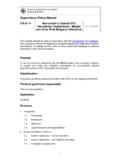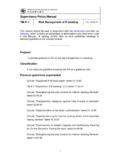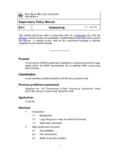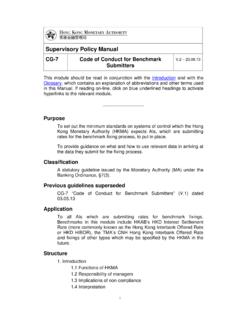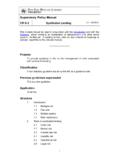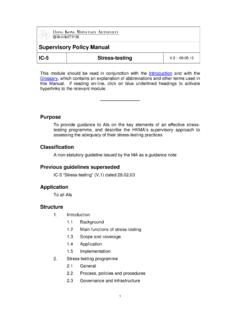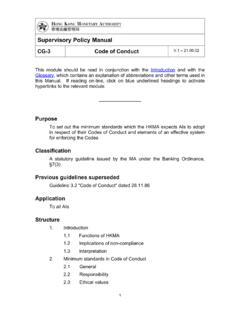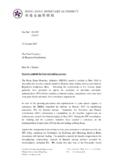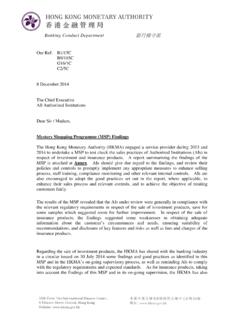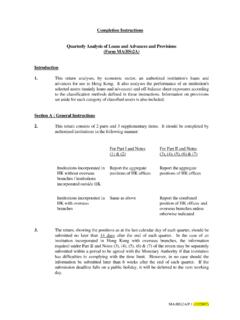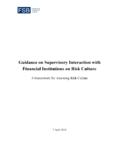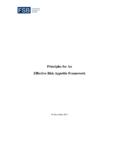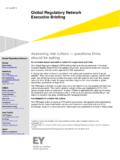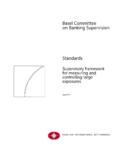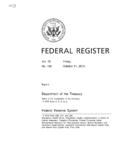Transcription of Supervisory Policy Manual - Hong Kong Monetary …
1 Supervisory Policy Manual IC- 1 risk management framework 1 This module should be read in conjunction with the Introduction and with the Glossary, which contains an explanation of abbreviations and other terms used in this Manual . If reading on-line, click on blue underlined headings to activate hyperlinks to the relevant module. Purpose To specify the key elements of a risk management framework which the MA expects AIs to have in place. Classification A statutory guideline issued by the MA under the Banking Ordinance, 7(3).
2 Previous guidelines superseded IC-1 General Risk management Controls ( ) dated and ( ) dated Application To all AIs. Structure 1. Introduction Background Application 2. Key elements of an effective risk management framework Risk governance Risk appetite framework 3. Responsibilities of the Board and senior management Overall responsibilities Setting of risk appetite and monitoring Firm-wide risk management Supervisory Policy Manual IC- 1 risk management framework 2 Use of specialised committees 4. Risk management policies, procedures and limits Policies and procedures Risk limits New products and services 5.
3 Risk management systems and processes Risk management function Risk management information system Risk measurement and assessment Risk-adjusted performance measurement Sensitivity analysis and stress-testing 6. Internal controls, audits and contingency planning Internal control system Internal audit function Compliance function Contingency, business continuity and recovery planning Supervisory Policy Manual IC- 1 risk management framework 3 1. Introduction Background Risk-taking is an integral part of banking business.
4 Each AI has to find an appropriate balance between the level of risk the AI is willing and able to take and the level of return it seeks to attain, without undermining its overall financial soundness and viability. An effective risk management framework , that is commensurate with the size and complexity of an AI s operations, needs to be in place to help ensure that risks are well managed within the AI s risk appetite and that the necessary systems and controls achieve their intended results. According to the Core Principles for Effective Banking Supervision issued by the Basel Committee on Banking Supervision in September 2012 ( Basel Core Principles ), banking supervisors should be satisfied that banks have in place a comprehensive risk management process (including Board and senior management oversight)
5 To identify, measure, evaluate, monitor, report and control or mitigate all material risks on a timely basis and to assess the adequacy of their capital and liquidity in relation to their risk profile and market and macroeconomic conditions. Consistent with the Basel Core Principles, the HKMA requires AIs, under its risk-based Supervisory approach, to establish a sound and effective system to manage each of the eight inherent risks (viz. credit, market, interest rate, liquidity, operational, reputation, legal and strategic) to which they are exposed (see SA-1 Risk-based Supervisory Approach ).
6 Locally incorporated AIs are also required to have adequate internal systems for assessing capital adequacy in relation to the risks they assume (as prescribed in CA-G-5 Supervisory Review Process ). This module is intended to set out the HKMA s expectations in respect of AIs risk management frameworks. Some of the specific systems and controls Supervisory Policy Manual IC- 1 risk management framework 4 associated with various inherent risks are separately described in other Application The standards in this module will be applied to AIs on a proportionate basis, having regard to their size, nature and complexity of operations.
7 Thus, AIs having a relatively small and simple business operation may not need to adopt and operate a risk management framework which is as extensive and as sophisticated as that of a large and complex AI. In general, locally incorporated AIs should apply these standards on the solo-entity basis and, where applicable, the consolidated basis covering their subsidiaries and, to the extent practicable, associated companies and joint ventures which may expose them to significant potential International banking groups operating in Hong Kong (whether in the form of a local subsidiary or a branch) should have a local risk management framework appropriate for their Hong Kong operations.
8 If certain risk management functions pertaining to a banking group s Hong Kong operations are centralized at the group or regional level, the AI, upon request by the HKMA, should be able to demonstrate that the relevant functions performed at the group or regional level are appropriate for the size, nature and complexity of the local operations and are in line with the standards in this module in all material aspects. Failure to adhere to the standards set out in this module may call into question whether an AI continues to satisfy the minimum criteria for authorization in the Banking Ordinance and cast doubt on the fitness and propriety of 1 For example: CR-G-1 General Principles of Credit Risk management ; CR-G-13 Counterparty Credit Risk management ; TA-2 Foreign Exchange Risk management ; IR-1 Interest Rate Risk management .
9 LM-2 Sound Systems and Controls for Liquidity Risk management ; OR-1 Operational Risk management ; RR-1 Reputation Risk management ; and SR-1 Strategic Risk management . 2 Whether the standards should be applied to associated companies or joint ventures will also depend on the extent of an AI s affiliation to the entities and the level of control it can exercise over the entities. Supervisory Policy Manual IC- 1 risk management framework 5 the AI s directors, chief executives and other members of its senior management .
10 2. Key elements of an effective risk management framework Risk governance Risk governance refers to the formal arrangements that enable the Board of Directors (the Board) and senior management of an AI to establish sound business strategy, articulate and monitor adherence to risk appetite and risk limits, and identify, measure, manage and control risks . To ensure effective risk management , an AI should have in place a set of robust risk governance arrangements, whereby responsibilities of the Board and senior management , and among different functions of the AI (and the respective risk owners), are well defined.
